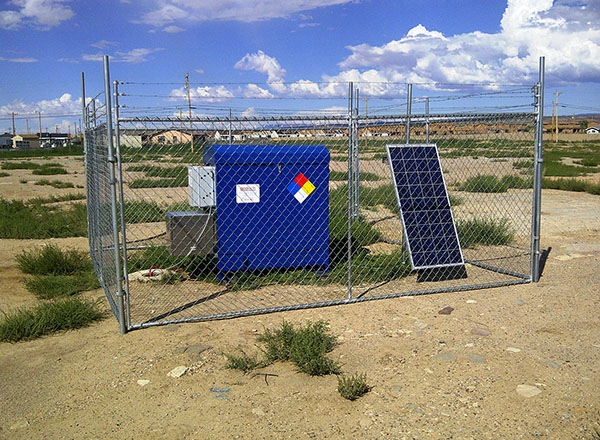
To begin proper management of an LNAPL site, one must first determine the problems or concerns that the LNAPL poses at the site. A complete site characterization and LCSM will help to identify these concerns. Once the concerns are identified, appropriate “LNAPL remedial objectives” are set to eliminate the LNAPL concerns at the site.
LNAPL remedial technologies are divided into three basic groups:
- LNAPL mass-recovery technology
- LNAPL mass-control technology
- LNAPL phase-change technology
The three technology groups are intended to help associate a technology with the general context of how that technology remediates the LNAPL. Further, the three technology groups illustrate how a remedial technology can be used in the context of the LNAPL remedial objectives and remediation goals.
For each LNAPL remediation goal, one or more “performance metrics” are defined. Performance metrics are measurable characteristics that relate to the remedial progress of a technology in abating the concern. The different LNAPL remediation technologies function differently (e.g., excavation vs. cosolvent flushing), and therefore, the performance metrics used to demonstrate progress toward and achievement of the LNAPL remediation goal depend on the technology used.
LNAPL Mass Recovery Technology
LNAPL mass-recovery technologies directly recover LNAPL via physical removal in the case of excavation or hydraulic recovery (e.g., LNAPL pumping or skimming). Hydraulic recovery may be pursued with or without flow augmentation by using remedial techniques that reduce LNAPL viscosity or interfacial tension (e.g., surfactants or solvents), thereby enhancing LNAPL flow. LNAPL mass recovery using pumping or skimming technologies is limited to reducing LNAPL saturation to residual saturation. At residual saturation, LNAPL will not flow and, therefore, hydraulic recovery is no longer possible.
Figure 1: LNAPL is pumped from recover well utilizing a total fluid pump
Figure 2: Skimmer can be used to pump the oil phase at controlled rate
Figure 3: Injection of surfactant to enhance the LNAPL pumping flow
LNAPL Phase Change Technology
LNAPL phase-change technologies do not directly remove LNAPL from the environment as is the case for LNAPL mass-recovery technologies. Instead, LNAPL phase-change technologies exploit the tendencies of LNAPLs to partition to other phases by increasing the rates of volatilization or dissolution of the LNAPL constituents by different means. Those LNAPL constituents are then degraded or captured in the vapor or dissolved phase and removed from the environment. As the LNAPL constituents are removed from the LNAPL, the composition of a multiconstituent LNAPL is changed by loss of the LNAPL constituents that readily degrade, volatilize, or dissolve from the LNAPL. LNAPL phase-change technologies are thus primarily applicable to composition-based LNAPL remedial objectives.
Figure 4: Thermal technology can change LNAPL phase into vapor or dissolved phase for easier recovery
LNAPL Mass-Control Technology
LNAPL mass-control technologies stabilize a migrating LNAPL by reducing the LNAPL saturation via blending a binding agent with the LNAPL zone (mixing technologies) or by physically blocking LNAPL migration (containment technologies). Specifically, LNAPL mass-control technologies are primarily suited for saturation-based LNAPL remedial objectives by limiting mobility or eliminating migration. The containment technologies are limited in applicability to LNAPL saturations in excess of residual saturation, since at residual saturations the LNAPL body is, by definition, immobile.
Figure 5: Mixing soil with binding material to contain the LNAPL
Following adequate and appropriate LNAPL assessment and LCSM development, the potential LNAPL concern(s) at the site, if any, are identified. For each identified concern, the associated LNAPL remedial objective to specifically resolve that LNAPL concern is established. The first column of table lists a range of LNAPL remedial objectives covering the typical spectrum of LNAPL concerns at sites.
An LNAPL remedial objective commonly has more than one LNAPL remediation goal (column 2), reflecting that typically more than one technology can achieve the LNAPL remedial objective. If multiple LNAPL remediation goals exist for an LNAPL remedial objective, then the objective can be achieved in multiple ways. Together, the technology group explain how the LNAPL is addressed in the context of that goal. A suite of potentially applicable technologies are associated with each LNAPL remediation goal.
Preliminary screening matrix
| LNAPL remedial objective | LNAPL remedial goal | Technology group | LNAPL technologies | |
| Reduce LNAPL saturation when LNAPL is above residual range | Recover LNAPL to max extent practicable | mass recovery | – multi/single phase extraction
(Product 1; 2) |
|
| Reduce LNAPL when LNAPL within residual saturation range | Further abate LNAPL beyond hydraulic or pneumatic recovery | mass recovery | – surfactant flushing (Product 1) – AS/SVE (Product 1) – ISCO (Product 1) – thermal enhanced extraction (Product 1; Product 2) – natural source zone depletion (NSZD) |
|
| Terminate LNAPL body migration and reduce potential for LNAPL migration | Abate LNAPL body migration by sufficient physical removal of mobile LNAPL mass | mass recovery | multiphase extraction (Product 1; Product 2) | |
| Stop LNAPL migration by physical barrier | mass control | physical containment | ||
| Sufficiently stabilize mobile LNAPL fraction to prevent migration | mass control | soil mixing | ||
| Abate accumulation of unacceptable constituent concentrations in soil vapor or dissolved phase from an LNAPL source | abate unacceptable vapor accumulation by sufficient depletion of volatile constituents in LNAPL | LNAPL phase change and mass recovery | – AS/SVE (Product 1) – Thermal desorption |
|
| abate unacceptable soil vapor concentration by physical barrier or containment | mass control | – Vapor barrier – SVE (Product 1) |
||
| control or treat soluble plume to abate unacceptable dissolved-phase concentration at a specified compliance point | mass control | – modified AS – hydraulic containment (Product 1) – multiphase extraction |
||
| Reduce constituent concentrations in soil vapor and/or dissolved phase from an LNAPL source | further reduction of groundwater and vapor concentration beyond acceptable level | LNAPL phase change | Natural source zone depletion |